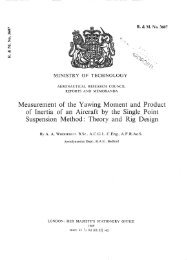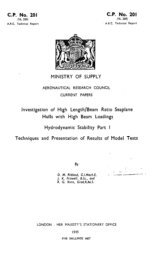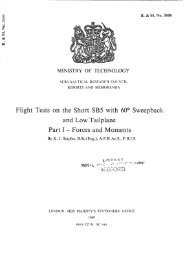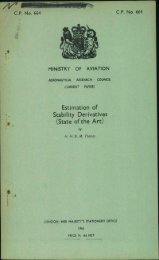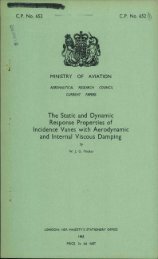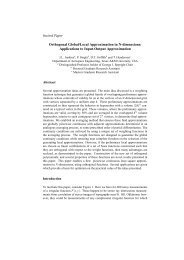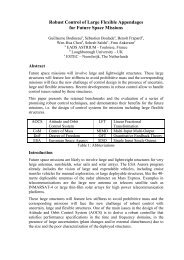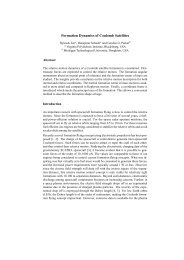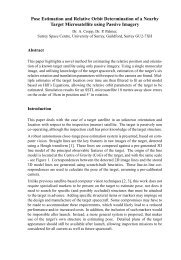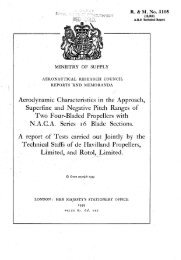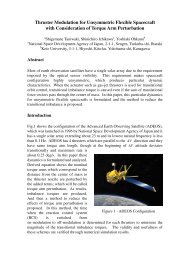The Aerodynamic Characteristics of Flaps
The Aerodynamic Characteristics of Flaps
The Aerodynamic Characteristics of Flaps
You also want an ePaper? Increase the reach of your titles
YUMPU automatically turns print PDFs into web optimized ePapers that Google loves.
ff<br />
We are mainly interested in the available lift coefficient increments at take-<strong>of</strong>f and landing,<br />
and it has, therefore, been decided 8' ~' 60 to adopt the increment at an incidence <strong>of</strong> 10 deg<br />
above the no-lift angles to define the lift coefficient increment <strong>of</strong> a flap, as this incidence is<br />
representative <strong>of</strong> the range <strong>of</strong> incidence in which we are interested. <strong>The</strong> increment is generally<br />
written d CL. It may be noted that an analysis by Stewarff ~ <strong>of</strong> some flight measurements <strong>of</strong><br />
CL~ax on various flapped wings suggests that the lift coefficient increment A CL is a good<br />
guide to the magnitude <strong>of</strong> the full scale increment in CL ~ax.<br />
<strong>The</strong> lift coefficient increment due to a flap is a function <strong>of</strong> the aspect ratio <strong>of</strong> the wing. This<br />
point will be dealt with in more detail later, but it may be noted here that for a flap that does not<br />
extend the wing chord, the increment varies with aspect ratio in exactly the same way as does<br />
the lift-curve slope <strong>of</strong> the wing alone. A curve representing this variation, derived by Levacic<br />
in an unpublished analysis <strong>of</strong> the latest available experimental data, is shown in Fig. 3 as the<br />
function F(A)/F(6). For convenience, the aspect ratio <strong>of</strong> 6.0 is taken as standard, unless<br />
otherwise stated, quoted values <strong>of</strong> lift coefficient increments refer to this aspect ratio.<br />
For a full-span flap, experiments show that the lift coefficient increment is practically independent<br />
<strong>of</strong> taper ratio 3.<br />
3.2. Pr<strong>of</strong>ile Drag Coefficent Imrement.--<strong>The</strong> increment .in pr<strong>of</strong>i!e drag coefficient due to a<br />
flap at a given incidence is rather more influenced by test conditions than is the lift coefficient<br />
increment. Nevertheless, the influence <strong>of</strong> test conditions and wing incidence is still sufficiently<br />
small over a wide range <strong>of</strong> incidence for us to accept the increment at a standard incidence as<br />
a reliable measure <strong>of</strong> the pr<strong>of</strong>ile drag characteristics <strong>of</strong> a flap. Since our main interest is centred<br />
on the effect <strong>of</strong> the flap drag on take-<strong>of</strong>f the standard incidence has been taken to be 6 deg above<br />
the no-lift angle a' ~. This increment is written as A Cv0.<br />
<strong>The</strong> pr<strong>of</strong>ile drag increment <strong>of</strong>'a flap is assumed to be independent~ .............. ~ ........ <strong>of</strong>~__._aa~o.<br />
3.3. Pitc/~ing Moment Coefficient Imrement.--<strong>The</strong> pitching moment coefficient increment<br />
<strong>of</strong> a wing due to a flap at a given incidence is always closely correlated with the lift coefficient<br />
increment. Like the latter it is practically independent <strong>of</strong> test conditions and, if the flap does<br />
not extend the wing chord, it is independent <strong>of</strong> wing incidence. As in the case <strong>of</strong> the lift coefficient<br />
increment, the standard incidence has been taken as 10 deg above the no-lift angle 3.<br />
In two important respects the pitching moment coefficient increment differs from the lift<br />
coefficient increment, firstly, theory ~ shows it to be independent <strong>of</strong> aspect ratio and secondly<br />
for a full-span flap it is a function <strong>of</strong> taper ratio.<br />
<strong>The</strong> pitching moment coefficien~ increment is written as A C,, and, unless otherwise stated,<br />
is referred to the wing quarter-chord point.*<br />
3.4. Exte~ded (or Reduced) Chords.--In correlating results obtained with flaps that extend<br />
the chord with those for flaps which do not. we must introduce the concept <strong>of</strong> effective or extended<br />
chord or area 3' 60<br />
<strong>The</strong> definition <strong>of</strong> the extended chord c' for a full-span flap is illustrated in Fig. 4a. If the flap<br />
is rotated about the point <strong>of</strong> intersection <strong>of</strong> the wing and flap chord lines until the two chord<br />
lines coincide, then the distance from the leading edge <strong>of</strong> the wing to the trailing edge <strong>of</strong> the<br />
flap in this position is defined as the extended chord.]- For a double flap tile definition follows<br />
along analogous lines Fig. 4b. <strong>The</strong> rear flap is first assumed to rotate about the point <strong>of</strong> intersection<br />
<strong>of</strong> the rear flap chord line with the front flap chord line until the two lines coincide, and<br />
then both flaps are rotated about the point <strong>of</strong> intersection <strong>of</strong> the front flap chord line and the<br />
wing chord line until these two chord lines coincide. <strong>The</strong> distance from the wing leading edge<br />
to the new Position <strong>of</strong> the trailing edge is defined as the extended chord.<br />
g<br />
* <strong>The</strong>re is, <strong>of</strong> course, an effect on the pitching moment <strong>of</strong> a complete aeroplane with flaps, due to the change <strong>of</strong> downwash<br />
at the tailplane accompanying the change in wing loading caused by the flaps. This effect is not considered here,<br />
but attention may be drawn to the work contained in Refs. 93 to 95.<br />
t <strong>The</strong> chord line <strong>of</strong> a flap is the line that is fixed in tile flap and is coincident with the wing chord line when the flap<br />
is fully retracted.<br />
7



